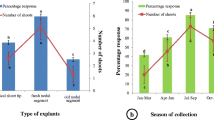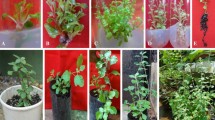Abstract
A rapid and efficient method for the regeneration of plantlets from root explants ofRobinia pseudoacacia L. by suspension culture was established. The roots taken from aseptically grown 15-day-old seedlings were used as explants. It was determined that photoperiodicity was necessary for root proliferation, and that the promotive effect of IAA (3-indoleacetic acid) on root proliferation was better than that of IBA (3-indolebutyric acid). The roots cultured in 1/2 MS liquid medium containing 3 µM IAA and 1% sucrose at 25°C under 16-hour photoperiod with 50 µmol m−2s−1 PPFD (photosynthetic photon flux density) shaking at 100 times/min reciprocally showed high efficiency for root proliferation. BAP (6-benzylaminopurine) was found to be essential to induce adventitious shoots from the roots, and the roots cultured in the medium supplied with 3 µM BAP combined with 1–6 µM IAA for 3 weeks under the same conditions as in the root proliferation period were most suitable for adventitious shoot inducement.
Similar content being viewed by others
Literature cited
Arrillaga, I. (1993) Regenerating plant fromin vitro culture of black locust cotyledon and leaf explants. Hort. Sci. 28: 942–945.
Arrillaga, I., Tobolski, J. J., and Merkle, S. A. (1994) Advances in somatic embryogenesis and plant production of black locust. Plant Cell Rep. 13: 171–175.
Barghchi, M. (1987) Mass clonal propagation ofRobinia pseudoacacia. Plant Sci. 53: 183–189.
Cella, R. and Iadarola, P. (1983) Characterization of carrot cell lines resistant to 5-methyltryptophan obtained by irradiating suspension culture with UV-light. Plant Sci. Lett. 29: 327–337.
Chalupa, V. (1983)In vitro propagation of willows (Salix spp.), European mountain ash (Sorbus ancuparia L.) and black locust (Robinia pseudoacacia L.). Biol. Plant 25: 305–307.
Chalupa, V. (1987a) Effect of bezylaminopurine and thidiazuron onin vitro shoot proliferation ofTilia cordata Mill.,Sorbus ancuparia L. andRobinia pseudoacacia L. Biol. Plant 29: 425–429.
Chalupa, V. (1987b) Vegetative propagation of broad-leaved woody species by cuttings and by anin vitro method. Lesnictví 33: 501–510.
Chalupa, V. (1988)In vitro propagation of small-leaved linden (Tilia cordata), black locust (Robinia pseudoacacia) and mountain ash (Sorbus ancuparia) and growth of trees cultivatedin vitro. Lesnictví 34: 705–720.
Chalupa, V. (1991) Somatic embryogenesis and plant regeneration inPicea, Quercus, Betula, Robinia, Fagus andAesculus. Commun. Inst. For. Cechosloveniae 15: 133–148.
Chen, R., Gyokusen, K., and Saito, A. (1996) Screening of NaCl-tolerantRobinia pseudoacacia L. callus throughin vitro culture. Bull. Kyusyu Univ. For. 75: 15–26. (in Japanese with English summary)
Civínova, B. and Sladký, Z. (1990) Stimulation of the regeneration capacity of tree shoot segment explantsin vitro. Biol. Plant. 32: 407–413.
Davis, J. M. and Keathley, D. E. (1985) Regeneration of shoots from leaf disk explants of black locust,Robinia pseudoacacia L. Proceedings 4th North Central Tree Improvement Conference, East Lansing, MI, Ang. 12–14, 29–34.
Davis, J. M. and Keathley, D. E. (1987a) Toward efficient clonal propagation of mature black locust trees using tissue culture. Nitrogen Fixing Tree Res. Rep. 5: 57–58.
Davis, J. M. and Keathley, D. E. (1987b) Differential responses toin vitro bud culture in matureRobinia pseudoacacia L. (black locust). Plant Cell Rep. 6: 431–434.
Davis, J. M. and Keathley, D. E. (1988)In vitro propagation of a black locust tree with an unusual phenotype. Nitrogen Fixing Tree Res. Rep. 6: 65–67.
Davis, J. M. and Keathley, D. E. (1989) Detection and analysis of T-DNA in crown gall tumors and kanamycin-resistant callus ofRobinia pseudoacacia. Can. J. For. Res. 19: 1118–1123.
Deguchi, M., Gyokusen, K., and Saito, A. (1994) Propagation of plantlets by the culture of multiple shoots and roots induced from callus originating in the cambium ofRobinia hispida L. J. Jpn. For. Soc. 74: 346–354. (in Japanese with English summary)
Flowers, T. J., Hajibagheri, M. A., and Clipson, N. J. W. (1986) Halophytes. The Q. Rev. Biol. 61: 313–337.
Fujiwara, A. and Ojima, K. (1955) Physiological studies of plant roots (part 1) — Influences of some environmental condition on growth of isolated roots of rice plant and wheat. J. Sci. Soil Manure, Jpn. 26: 295–298. (in Japanese with English summary)
Fukuda, T. (1994) Tissue culture of black locust. Plant Cell Technol. 16: 61–65. (in Japanese with English summary)
Fukuda, T. and Koumoto, M. (1986) Studies on tissue culture of tree — cambium X: Lignin-carbohydrate complex in suspension-cultured cells ofRobinia pseudoacacia. Mokuzai Gakkaishi Jpn. 32: 827–832.
Gebhardt, C., Schnebli, V., and King, P. J. (1981) Isolation of biochemical mutants using haploid mesophyll protoplasts ofHyoscyamus muticus. Planta 153: 81–89.
Han, K. H. and Keathley, D. E. (1988) Isolation and culture of protoplasts from tissue of black locust (Robinia pseudoacacia L.). Nitrogen Fixing Tree Res. Rep. 6: 68–70.
Han, K. H., Davis, J. M., and Keathley, D. E. (1990) Differential responses persist in shoot explants regenerated from callus of two mature black locust trees. Tree Physiol. 6: 235–240.
Han, K. H., Keathley, D. E., and Gordon, M. P. (1993a) Cambial tissue culture and subsequent shoot regeneration from mature black locust (Robinia pseudoacacia L.). Plant Cell Rep. 12: 185–188.
Han, K. H., Keathley, D. E., Davis, J. M., and Gordon, M. P. (1993b) Regeneration of a transgenic woody legume (Robinia pseudoacacia L., black locust) and morphological alterations induced byAgrobacterium rhizogenes mediated transformation. Plant Sci. 88: 149–157.
Hu, Q. J. and Han, Y. F. (1985) A study on induction of plantlets from mature leaves ofRobinia pseudoacacia. Hereditas, China 7 (4): 20–21. (in Chinese with English summary)
Kang, J. M., Kojima, K., Ide, Y., and Sasaki, S. (1996) Growth response to the stress of low osmotic potential, salinity and high pH in culture shoot of Chinese poplars. J. For. Res. 1: 27–29.
Kochba, J., Ben-Hayyim, G., Spiegel-Roy, P., Saad, S., and Neumann, H. (1982) Selection of stable salt-tolerant callus cell lines and embryos inCitrus sinensis andC. aurantiom. Z. Pflanzenphysiol. Bd. 106s: 111–118.
Kuraishi, S. and Nishinari, N. (1973) An introduction to the principles of plant physiology. 626pp, Tokyo University, Tokyo. 379–389 (in Japanese)
Merkle, S. A. and Wiecko, A. T. (1989) Regeneration ofRobinia pseudoacacia via somatic embryogenesis. Can. J. For. Res. 19: 285–288.
Murashige, T. and Skoog, F. (1962) A revised medium for rapid growth and bioassays with tobacco tissue culture. Physiol. Plant. 15: 473–497.
Singh, J. and Siminovitch, D. (1976) A reliable method for the estimation of DNA in higher plant tissues. Anal. Biochem. 71: 308–317.
Tarczynski, M. C., Jensen, R. G., and Bohnert, H. J. (1993) Stress protection of transgenic tobacco by production of the osmolyte mannitol. Science 259: 508–510.
Vértesy, J. and Balla, G. (1985) Micropropagation ofRobinia pseudoacacia. MÉN Inform. Központja: 63–71.
Zou, D. B., Gyokusen, K., and Yahata, H. (1994) Regeneration of plantlets by callus culture ofRobinia pseudoacacia L. Sci. Bull. Fac. Agric. Kyushu Univ. 49: 1–7. (in Japanese with English summary)
Author information
Authors and Affiliations
About this article
Cite this article
Chen, R., Gyokusen, K. & Saito, A. Plantlets regeneration from root explants ofRobinia pseudoacacia L. by suspension culture. J For Res 3, 161–165 (1998). https://doi.org/10.1007/BF02762138
Accepted:
Issue Date:
DOI: https://doi.org/10.1007/BF02762138




